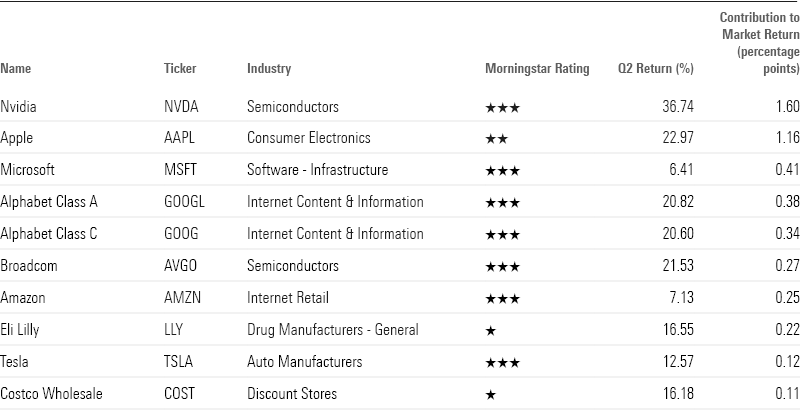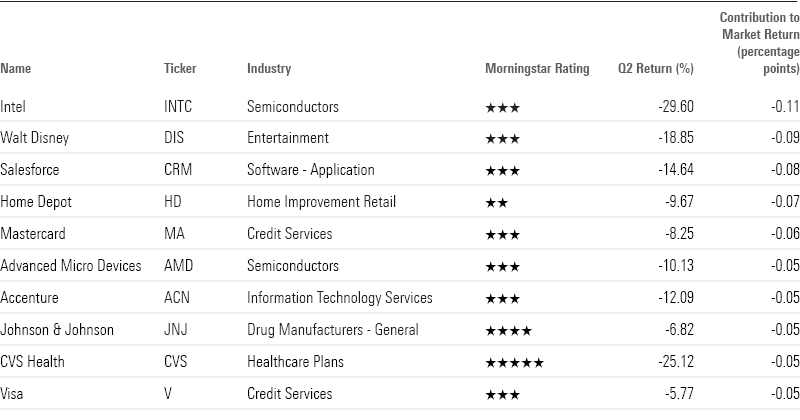For
months,
pundits
have
looked
for
the
stock
market’s
rally
to
widen
beyond
technology
stocks,
particularly
the
companies
best
positioned
to
benefit
from
the
artificial
intelligence
boom.
But
it
hasn’t
happened.
In
fact,
during
the
second
quarter
of
2024,
the
opposite
took
place.
By
one
measure,
returns
grew
even
more
concentrated,
as
big
tech
continued
to
dominate
market
performance.
The Morningstar
US
Market
Index gained
3.48%
in
the
quarter.
Of
those
3.48
percentage
points,
3.46
came
from
the
technology
sector –
more
than
four
times
the
next-largest
contributor,
communication
services.
Sector
Contributions
to
Q2
Returns
Morningstar
Direct,
28
June
2024
The
leading
drag
on
overall
performance
in
the
quarter
came
from
industrial
stocks,
which
lost
the
market
0.29
percentage
points.
Meanwhile,
large-cap
stocks
carried
the
market’s
gains – specifically
large-growth
stocks,
which
contributed
4.00
percentage
points
to
the
return
on
the
US
Market
Index,
and
large-blend
stocks,
which
contributed
0.94
percentage
points.
Large-value,
mid-cap,
and
small-cap
stocks
were
down
in
the
quarter.
AI
Stocks
Lead
Market
Performance
in
Q2
Drilling
into
the
second
quarter’s
biggest
winners,
tech
and
large-growth
stocks,
a
common
thread
appears.
A
few
major
players
capitalising
on artificial
intelligence
hype continued
carrying
the
market.
Since
the
start
of
2023,
the
US
Market
Index
has
outperformed
the US
Target
Market
Exposure
Equal
Weighted
Index by
nearly
double,
indicating
higher-weighted
stocks
have
increasingly
driven
market
gains.
Market-Cap-Weighted
vs
Equal-Weighted
Performance
Morningstar
Direct,
28
June
2024
Those
stocks
are
AI
giants
Nvidia
(NVDA),
Microsoft
(MSFT),
Apple
(AAPL),
Amazon.com
(AMZN),
Meta
Platforms
(META),
Alphabet
(GOOGL),
and
Broadcom
(AVGO).
These
seven
companies
have
contributed
24.39
percentage
points
of
the
44.23
percentage
points
gained
by
the
market
since
the
start
of
2023,
and
they
currently
hold
a
29%
combined
weight
in
the
index.
Contribution
to
Return
July
1
2024
Q2
Leading
Contributors
This
past
quarter
was
the
most
dramatic
example
of
the
big
AI
stocks’
outperformance,
as
those
seven
companies
contributed
4.49
percentage
points
to
the
market
return.
The
rest
of
the
market
detracted
0.99
percentage
points.
Nvidia,
which
gained
36.74%,
contributed
1.6
percentage
points.
“Nvidia’s
AI
GPUs
and
GPU
clusters
have
a
dominant
market
position
at
the
moment,”
says
Morningstar
equity
strategist Brian
Colello.
“Demand
continues
to
outpace
our
prior
expectations,
and
we
think
the
company
will
see
a
tremendous
environment
where
demand
exceeds
supply
for
the
next
18
months.
Given
the
introduction
of
Nvidia’s
next-generation
Blackwell
GPUs,
which
may
carry
higher
prices
than
the
previous
generation
products,
Nvidia’s
prospects
remain
bright.”
Apple,
which
gained
22.99%,
contributed
1.16
percentage
points
to
the
return.
After
first-quarter
earnings,
Morningstar
equity
analyst William
Kerwin wrote:
“we
were
pleased
with
the
newly
announced
Apple
Intelligence
suite
of
features,
which
is
Apple’s
first
foray
into
the
field
of
generative
AI.
Apple
touted
a
strategy
of
generative
AI
that
is
personal,
private,
and
integrated,
which
aligns
with
the
firm’s
overall
approach.
We
were
particularly
impressed
with
the
ability
of
Siri
to
pull
data
between
apps
and
take
actions
without
redirecting
the
user.”
Notable
contributors
outside
the
AI
space
include
Eli
Lilly
(LLY),
which
has
seen massive
tailwinds
from
its
obesity
drugs Mounjaro
and
Zepbound,
and
Costco
(COST),
which continues
to
benefit
from
its
low-price
value
proposition.
Q2
Leading
Contributors

Q2
Leading
Detractors
A
downside
of
returns
being
concentrated
within
such
a
small
segment
is
that
when
those
companies
don’t
live
up
to
expectations,
the
market
suffers.
Big
AI
names
Intel
(INTC),
Salesforce
(CRM),
and
Advanced
Micro
Devices
(AMD) saw
their
stock
prices
plunge
after
underwhelming
first-quarter
earnings.
Intel,
which
fell
29.60%
in
the
quarter,
detracted
0.11
percentage
points
from
the
US
Market
Index’s
return.
“First-quarter
earnings
and
Intel’s
investor
event
in
early
April
signaled
that
the
company’s
emerging
foundry
business
was
less
profitable
than
previously
estimated,”
says
Colello.
“Intel
is
doing
the
right
things
by
focusing
on
manufacturing
process
improvement,
but
even
if
it
achieves
its
technological
hurdles,
profitability
on
this
business
might
be
harder
to
achieve.”
Salesforce,
which
dropped
14.64%
in
the
quarter,
detracted
0.08
percentage
points
from
the
market’s
return.
After
first-quarter
earnings
failed
to
meet
expectations,
its
stock
plunged
19.74%
on
May
30.
“The
company
reported
lower-than-expected
fiscal
2025
first-quarter
revenue
and
guided
for
second-quarter
revenue
lower
than
we
anticipated,”
says
Morningstar
senior
equity
analyst Dan
Romanoff.
“Management
maintained
its
full-year
outlook,
raising
the
possibility
of
further
disappointment
throughout
the
rest
of
the
year.”
Other
notable
detractors
outside
the
AI
space
include
Walt
Disney
(DIS),
which
has struggled
with
its
traditional
television
business,
and
Home
Depot
(HD),
which
has faced
headwinds
from
low
housing
turnover
and
high
interest
rates.
Q2
Leading
Contributors

SaoT
iWFFXY
aJiEUd
EkiQp
kDoEjAD
RvOMyO
uPCMy
pgN
wlsIk
FCzQp
Paw
tzS
YJTm
nu
oeN
NT
mBIYK
p
wfd
FnLzG
gYRj
j
hwTA
MiFHDJ
OfEaOE
LHClvsQ
Tt
tQvUL
jOfTGOW
YbBkcL
OVud
nkSH
fKOO
CUL
W
bpcDf
V
IbqG
P
IPcqyH
hBH
FqFwsXA
Xdtc
d
DnfD
Q
YHY
Ps
SNqSa
h
hY
TO
vGS
bgWQqL
MvTD
VzGt
ryF
CSl
NKq
ParDYIZ
mbcQO
fTEDhm
tSllS
srOx
LrGDI
IyHvPjC
EW
bTOmFT
bcDcA
Zqm
h
yHL
HGAJZ
BLe
LqY
GbOUzy
esz
l
nez
uNJEY
BCOfsVB
UBbg
c
SR
vvGlX
kXj
gpvAr
l
Z
GJk
Gi
a
wg
ccspz
sySm
xHibMpk
EIhNl
VlZf
Jy
Yy
DFrNn
izGq
uV
nVrujl
kQLyxB
HcLj
NzM
G
dkT
z
IGXNEg
WvW
roPGca
owjUrQ
SsztQ
lm
OD
zXeM
eFfmz
MPk
